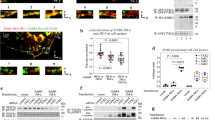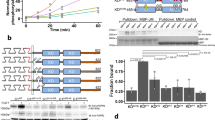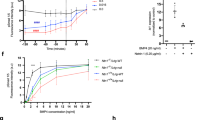Abstract
RECEPTOR tyrosine kinases of the EPH class have been implicated in the control of axon guidance and fascieulation1–7, in regulating cell migration8, and in defining compartments in the developing embryo9–11. Efficient activation of EPH receptors generally requires that their ligands be anchored to the cell surface, either through a transmembrane (TM) region or a glycosyl phosphatidylinositol (GPI) group12. These observations have suggested that EPH receptors can transduce signals initiated by direct cell–cell interaction. Genetic analysis of Nuk, a murine EPH receptor that binds TM ligands, has raised the possibility that these ligands might themselves have a signalling function6. Consistent with this, the three known TM ligands have a highly conserved cytoplasmic region, with multiple potential sites for tyrosine phosphorylation12–17. Here we show that challenging cells that express the TM ligands Elk-L or Htk-L with the clustered ectodomain of Nuk induces phosphorylation of the ligands on tyrosine, a process that can be mimicked both in vitro and in vivo by an activated Src tyrosine kinase. Co-culture of cells expressing a TM ligand with cells expressing Nuk leads to tyrosine phosphorylation of both the ligand and Nuk. These results suggest that the TM ligands are associated with a tyrosine kinase, and are inducibly phosphorylated upon binding Nuk, in a fashion reminiscent of cytokine receptors18. Furthermore, we show that TM ligands, as well as Nuk, are phosphorylated on tyrosine in mouse embryos, indicating that this is a physiological process. EPH receptors and their TM ligands therefore mediate bidirectional cell signalling.
This is a preview of subscription content, access via your institution
Access options
Subscribe to this journal
Receive 51 print issues and online access
$199.00 per year
only $3.90 per issue
Buy this article
- Purchase on SpringerLink
- Instant access to full article PDF
Prices may be subject to local taxes which are calculated during checkout
Similar content being viewed by others
References
Pasquale, E. B., Deerinck, T. J., Singer, S. J. & Ellisman, M. H. J. Neurosci. 12, 3956–3967 (1992).
Henkemeyer, M. et al. Oncogene 9, 1001–1014 (1994).
Winslow, J. W. et al. Neuron 14, 973–981 (1995).
Drescher, U. et al. Cell 82, 359–370 (1995).
Cheng, H.-J., Nakamoto, M., Bergemann, A. D. & Flanagan, J. G. Cell 82, 371–381 (1995).
Henkemeyer, M. et al. Cell 86, 35–46 (1996).
Tessier-Lavigne, M. Cell 82, 345–348 (1995).
Pandey, A., Shao, H., Marks, R. M., Polverini, P. J. & Dixit, V. M. Science 268, 567–569 (1995).
Xu, Q., Alldus, G., Holder, N. & Wilkinson, D. G. Development 121, 4005–4016 (1995).
Xu, Q., Alldus, G., Macdonald, R., Wilkinson, D. G. & Holder, N. Nature 381, 319–322 (1996).
Gale, N. W. et al. Neuron 17, 9–19 (1996).
Davis, S. et al. Science 266, 816–819 (1994).
Beckmann, M. P. et al. EMBO J. 13, 3757–3762 (1994).
Shao, H., Lou, L., Pandey, A., Pasquale, E. B. & Dixit, V. M. J. Biol. Chem. 269, 26606–26609 (1994).
Bergemann, A. D., Cheng, H.-J., Brambilla, R., Klein, R. & Flanagan, J. G. Mol. Cell Biol. 15, 4921–4929 (1995).
Bennett, B. D. et al. Proc. Natl Acad. Sci. USA 92, 1866–1870 (1995).
Gale, N. W. et al. Oncogene 13, 1343–1352 (1996).
Taniguchi, T. Science 268, 251–255 (1995).
Brambilla, R. et al. EMBO J. 14, 3116–3126 (1995).
Songyang, Z. et al. Nature 373, 536–539 (1995).
Nelson, P. G., Christian, C. N. & Nirenberg, M. Proc. Natl Acad. Sci. USA 73, 123–127 (1976).
Peles, E. et al. Cell 82, 251–260 (1995).
van Essen, D., Kikutani, H. & Gray, D. Nature 378, 620–623 (1995).
Owens, T. Curr. Biol. 6, 32–35 (1996).
Liu, X. et al. Oncogene 8, 1119–1126 (1993).
Cerretti, D. P. et al. Mol. Immunol. 32, 1197–1205 (1995).
Lhotak, V. & Pawson, T. Mol. Cell Biol. 13, 7071–7079 (1993).
Ellis, C. et al. Oncogene 12, 1727–1736 (1996).
Nicola, N. A., Viney, E., Hilton, D. J., Roberts, B. & Willson, T. Growth Fact. 13, 141–149 (1996).
Author information
Authors and Affiliations
Rights and permissions
About this article
Cite this article
Holland, S., Gale, N., Mbamalu, G. et al. Bidirectional signalling through the EPH-family receptor Nuk and its transmembrane ligands. Nature 383, 722–725 (1996). https://doi.org/10.1038/383722a0
Received:
Accepted:
Issue Date:
DOI: https://doi.org/10.1038/383722a0
This article is cited by
-
EphB2 receptor tyrosine kinase promotes hepatic fibrogenesis in mice via activation of hepatic stellate cells
Scientific Reports (2018)
-
Ephrin ligands and Eph receptors contribution to hematopoiesis
Cellular and Molecular Life Sciences (2017)
-
Mechanisms of ephrin–Eph signalling in development, physiology and disease
Nature Reviews Molecular Cell Biology (2016)
-
Axon Guidance Molecules and Neural Circuit Remodeling After Spinal Cord Injury
Neurotherapeutics (2016)
-
Anti-angiogenic alternatives to VEGF blockade
Clinical & Experimental Metastasis (2016)



